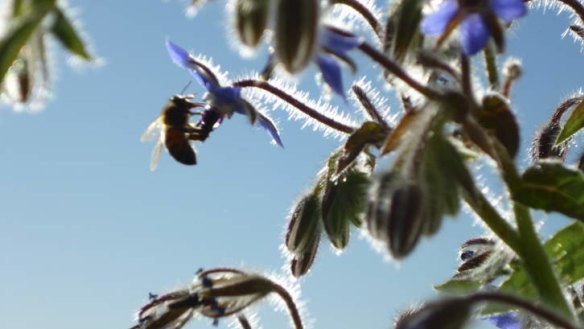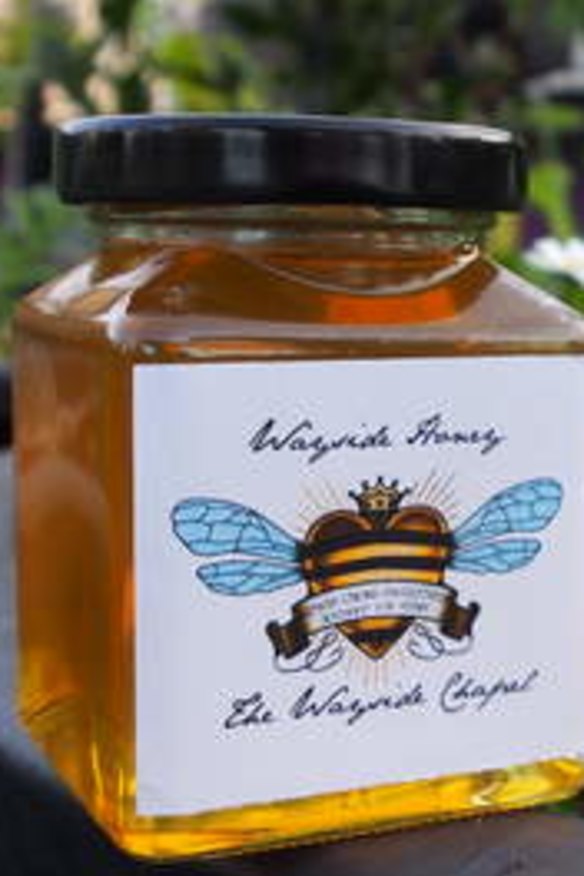Bees all the buzz on 13th floor
We need to nourish bees everywhere to protect our food supply, writes Indira Naidoo.

This photo captures the precise moment I fell in love with bees.
I was crouching, camera poised, on the balcony of my 13th floor inner-city Sydney apartment, the bright winter sun backlighting the soft hairs on the stems of my borage flowers.
I'd been like this for 40 minutes, middle-aged knees creaking uncomfortably, waiting to see if my sweet-nectared borage would do what I was hoping – attract some bees.
I knew the chances were slim. I'd never seen a bee on my balcony. And being nastily allergic (and phobic) to their stings, I'd always thought that was a good thing.
The situation is different now. I was attempting to grow organic vegetables in pots on my 20-square-metre balcony and as a new gardener I had discovered that many of my vegetables, especially my zucchinis, wouldn't fruit unless their flowers had been pollinated by bees. When my weekly food forage is restricted to the aisles of a fluoro-lit supermarket, it's not surprising I was oblivious to the vital role bees played in growing my food.

I did some research and discovered that honey bees find borage flowers irresistible. The flowers have beautiful five-pointed mauve petals and produce a heady sugary syrup. The plan was that the bees would make a beeline for the borage pollinating my vegies in the process. At least that was the theory. I was sceptical though. How could a tiny bee find a borage bloom on a balcony in Potts Point surrounded by concrete, steel, tarmac and inner-city pollution? Heck, sometimes I even struggled to find my way home.
So you can imagine my disbelief when this little gal (only female bees collect pollen) buzzed onto my balcony unaware of the fanfare her arrival would cause. There I was, a solo paparazzo, clicking my camera feverishly as if capturing a royal visit.
And you know that same little bee (I'm pretty sure it was the same one) would visit my balcony every day at sunrise and sunset sipping the borage nectar as if she was downing cocktails at a Club Med. Eventually she brought some mates and miracle upon miracle my zucchini flowers soon transformed from egg-yellow trumpets into long, delicious, zucchinis.
For other food growers, though, attracting bees isn't so easy.
No one is keeping accurate figures but some reports say as much as 80 per cent of the wild bee populations of some countries – such as the US and Spain – could have already perished.
It's been well documented how colony collapse disorder, the use of certain GMO crops and agricultural pesticides known as neonicotinoids, may be contributing to their destruction.
Neonicotinoids are some of the most-used pest control chemicals in the world. They can be applied to grown plants or trees – even to seeds. The chemical is absorbed by the growing plant and becomes part of its structure (its roots, leaves, nectar or pollen), so an insect that ingests any part of the plant will get a nasty dose of neonicotinoid in its meal.
These doses may not kill the insect immediately, but over time, repeated uptake of the chemical will build up in the insect's system and paralyse its health, behaviour and reproductive success.
Recently some EU countries imposed a controversial ban on the use of neonicotinoids on flowering crops. These chemicals are also used here but so far the Australian government has resisted mounting pressure to follow suit.
There's a lot at stake.
Sixty-five per cent of agricultural production in Australia depends on pollination by European honey bees. Thirty-five Australian industries are dependent on honey bee pollination for most of their production. And industries such as cherry, almond, apples and pears are almost totally reliant on honey bees (source: RIRDC, Pollination Five-Year R&D Plan, 2009-2014, August 2009).
And there's another bee killer stalking our shores.
The Varroa mite has been decimating honey bee populations globally. It infiltrated New Zealand 4 years ago leaving Australia the only Varroa-free zone left in the world. Many farmers fear it's only a matter of time before the mite strikes our hives.
Former ABC TV investigative reporter John Millard, now a bee-keeper, believes it's never been more important to help expand and maintain healthy bee populations especially in our cities.
Millard has spent the past 12 years establishing beehives in the most unlikely of places.
Last year, he set up a hive on the rooftop vegetable garden of the Wayside Chapel, a homeless crisis centre at Potts Point where I am an ambassador. Millard and I help run gardening and bee-keeping classes for the Wayside's homeless visitors.
"It's wonderful to see their (the Wayside's clients) fascination with the bees ... to see their amazement as they take out a frame and see it dripping with honey," Millard says.
"Honey is almost a daily part of what we eat but how bees make it remains a mystery to most of us," he says.
The Wayside hive has been particularly productive since it was installed last summer.
Millard says the queen bee is aggressive and a good egg-layer and the hive now has 40,000 to 50,000 worker bees producing more than 30 kilograms of honey a year. Most of this is used in meals prepared for the Wayside's cafe.
The Wayside bees forage for nectar and pollen in a five-kilometre radius from the hive. This takes in the Wayside vegetable garden, the nearby Sydney Royal Botanic Gardens, Centennial Park – and quite possibly my own balcony.
The flowers they visit give the Wayside honey a distinctive flavour and aroma.
"I think our bees mainly visit jacaranda and melaleuca flowers so the honey we get is very clear and sugary," Millard says.
"And because our honey hasn't been heated and processed like commercial honeys, it has a much better flavour."
Millard says beehives are low maintenance and mostly look after themselves, making them ideal for rooftops or backyard gardens.
And what about the community's fear about bee stings that stops many from developing a good relationship with bees?
Millard says beehives can readily co-exist with people in the city and the fear that bees will regularly sting is unfounded.
"We do have a duty of care which we take seriously so the Wayside hive is in a fenced off area on the roof so no one is tempted to agitate the bees when I'm not there to supervise," he says.
"The reality is that bees are everywhere, all the time ... in our gardens and parks.
"They rarely trouble you and in exchange they do us this great philanthropic service. But there are also native stingless bee varieties you can keep if you are really concerned."
Irrational fears are difficult to dispel because they are just that, irrational.
But if we are to truly protect these tiny creatures and the future of our diverse food supply, we should start accepting that we pose a greater risk to bees, than they do to us.
If you'd like to visit the Wayside Chapel's Rooftop Community Garden and bee hive or Indira's Edible Balcony please contact Urban Food Safari.
Restaurant reviews, news and the hottest openings served to your inbox.
Sign up